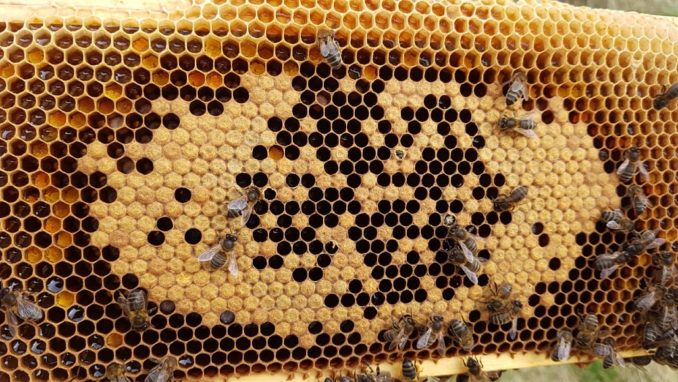
© Putin Itaboutbit
I’m assuming you are only reading this because Swiss Bob has run out of:
- faggot and quiche recipes, and/or
- Old Trout’s maths questions, that bring back nightmares of my ‘A’ levels from longer ago than I want to remember.
A while ago, one of you lot suggested I should write something about bees, so some years later than planned, and after Jethro beat me to it last year, here goes. You’ve only got yourselves and COVID-19 lockdown to blame.
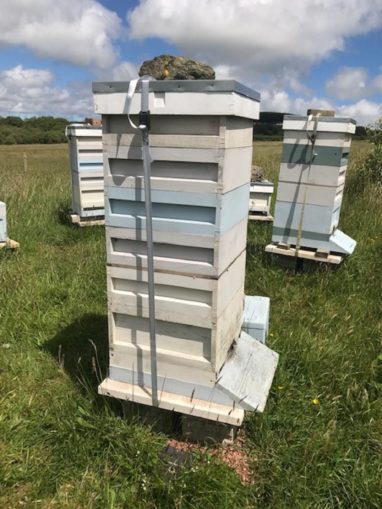
© Putin Itaboutbit
I’ve kept bees now for about 10 years and have 10 hives split between 4 separate apiaries dotted around the Isle of Man. It’s a fairly expensive hobby to start – complete hives cost around £250, plus there’s all the gear you need – suit, smoker, gloves and the indispensable hive tool. Then there’s finding somewhere to keep them – accessible but secluded is the key, I’ve found. And once you get going there’s the extra cost of all the honey extraction gear, plus glass jars and labels, but let’s not get ahead of ourselves.
New beekeepers should ideally join a local beekeeper’s association to get some practical experience and attend some beginner’s classes if they can before diving in – it’s good to have a grasp of the basics and you never really know how you are going to react to a hive full of bees until you see them up close, so better to know if they will freak you out before wasting your money!
If none of this puts you off, you can buy some locally sourced bees from a known supplier or you might even get lucky and be given a captured swarm by another beekeeper to get you going.
They are fascinating little fellows. At the height of summer in a fully functioning hive there will be something like 50,000 worker bees (all female), a few hundred drones (male bees) and one queen (not trans or a lady boy bee, a proper big girl) – very much on the model of other collective insect colonies, like ants, or those aliens that like Sigourney Weaver so much. The workers, er…, do all the work, that is clean the hive, behind the fridge, feed and look after the queen, raise the young, build the comb (from wax producing glands on their undersides) and once they are a couple of weeks old, fly find some flowers and bring back nectar and pollen from the big bad world outside.
It’s all go being a worker – they work themselves to death and in summer will be lucky to make it to five or six weeks before dropping dead of exhaustion. Winter laid workers have a different physical make up compared to spring and summer laid workers – more fat mainly, which helps them to live much longer (6 months or so) so that they can keep the colony ticking over in the dormant winter months. Drones are bigger than workers and have no sting. They live like kings for a few months, get fed and looked after by the workers, fly around like B-52 bombers and can come and go as they please, entering any hives unmolested. Their sole purpose in life is to mate with virgin queens – a bit like Marc Almond. A queen will mate on the wing with a football team’s worth of drones, shamelessly banging them in succession until she is full to bursting with drone jizz, er…a bit like Marc Almond. As each drone climaxes, their knob explodes and they drop dead with a huge smile on their face. The queen then returns to the hive and spends the rest of her 3 to 5-year life as an egg laying slave, kept alive by the hive only as long as she can keep up egg production.
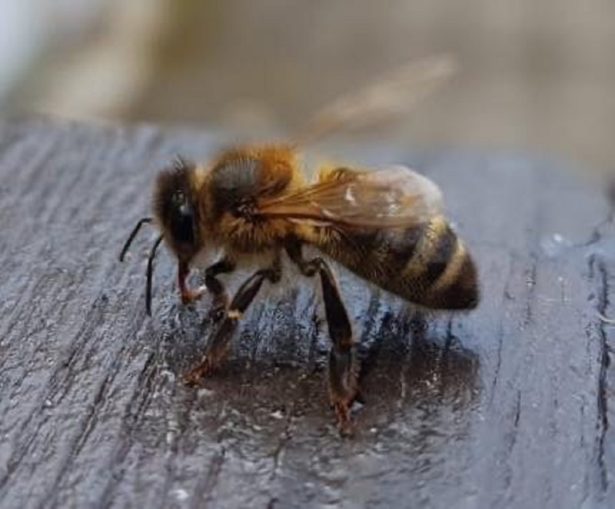
© Putin Itaboutbit
The queen regulates the temperament of the rest of the hive. She gives off pheromones, which among other things tells the rest of the hive that she is present, and a hive with a young active queen is usually happy. As she gets older, her power recedes and eventually the hive will decide to replace her. They raise a replacement and its possible that the old and new queen can work together for a period of time before the workers stop feeding the old lady and she slowly starves to death, alone and unwanted. Like Marc Almond. There’s also the possibility that the clumsy fuckwit of a beekeeper does her in by accident, or drops her outside the hive and doesn’t notice when he is fannying about. Queenless hives are much more aggressive and defensive than those that aren’t and give off a discernible and disconcerting ‘roar’, so you can usually tell fairly quickly.
One of the many things I find mind blowing about bees is each egg has the capacity to be a worker, a drone, or a queen. Drone eggs are unfertilised, worker eggs are fertilised and queens always start off as hatched worker larvae, but are fed royal jelly that changes their physical makeup. So, a queen knows she is laying drones or workers, but only the workers have the power to create a new queen.
Swarming is the natural tendency of bees to reproduce and usually happens in May and June. Why they decide to swarm is one of the great mysteries of nature, but it could be down to a lack of space in the hive, or just that the old queen is starting to go off, so now is as good a time as any. The workers stop feeding the queen to slim her down for flight and start to build a few special cells in which to house the replacement queen(s). The old girl flies off with roughly half the hive and finds somewhere to set up a new hive – probably my neighbour’s chimney. You can then get a succession of swarms from the same hive as each virgin queen hatches – or better still, the first new queen hatches and then runs around the hive killing off any unhatched pretenders by stinging them to death in their unopened queen cell, whilst manically laughing.
I am on the local beekeepers’ association swarm call out list and during May and June my phone is non stop with shrieking old people mistaking every possible animal for a swarm of bees. Every so often they are right and I get some free bee freebies, and possibly a new millionaire widow milf to add to my contacts book.
Towards the end of summer, the drones become an unnecessary drain on resources and get kicked out of the hive as there is now no likelihood of potential queen banging. There’s nothing like seeing the workers humanely nibble off the big guys wings and push them out of the hive to slowly starve to death, alone and unwanted, er…just like (there’s a theme here somewhere…)
My job as a beekeeper is to keep my bees in tip top condition, give them plenty of space to store surplus honey, keep an eye out for disease and try to stop them being a nuisance by managing swarming in the Spring and Summer.

© Putin Itaboutbit
As I may occasionally mention, I am infinitely fortunate to live on the beautiful Isle of Man (despite the ‘shit’ weather – see below), which is one of the few places left on the planet where beekeeping continues as it has done for hundreds of years. Through good luck or good planning, the Isle of Man Government instigated an import ban on bees and second hand equipment back in the late 1980’s and this has kept us free from the main diseases and parasites that have devastated honey bee colonies in the UK and elsewhere in recent times.
The main terrors we have so far avoided are the Asian Hornet (no hornet species at all here) and the nasty little shits otherwise known as the parasitic varroa mite. There have also been no reported incidences of other common diseases, such as the two types of foul brood, for years. As a result, my bees don’t need annual chemical treatments to kill the bastard varroa mites and other horrors, so true Manx honey is probably a damned sight purer than most.
Lack of chemicals also means we still have lots of hives that contain braula, a rather strange wingless fly that piggy backs on the workers and queen, and survives by robbing a bit of honey. They are otherwise harmless and have evolved to live symbiotically with honey bees. They must add something otherwise the bees would kick them out, but I and science in general are buggered if we know. Perhaps they tell a good joke or provide a bit of massage therapy.
Another benefit of the import ban is that Manx bees are mostly still native north European black bees – a distinct honey bee sub species (Apis mellifera mellifera, or AMM) once the predominant honey bee in Northern Europe but now mostly replaced by hybrids of other European sub species through systematic genocide by well-meaning beekeepers. There are some remaining AMM strongholds in Scotland, Wayyyyeeellls, Ireland and continental Europe, despite Brexit. AMM bees are better suited to our temperate north European climate (locally defined as ‘shit’ – cooler summers, periods of prolonged bad weather, cool winters, strong winds, endless fucking rain), than say a Mediterranean sub species would be; they are thrifty (don’t need huge quantities of honey to live on and store lots of surplus), can fly at lower temperatures than less manly bees and queens are generally not prolific layers of eggs (so don’t need loads of room to raise new bees). As a result, winter losses tend to be low and honey yields are reasonably high.
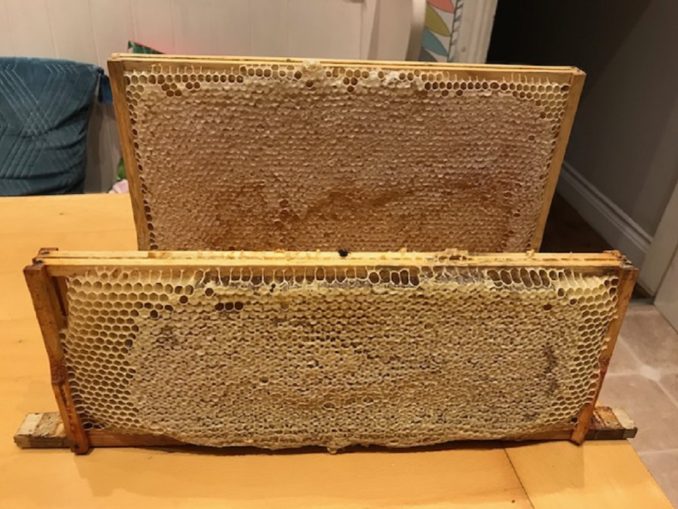
© Putin Itaboutbit
The highlight for me once (August/Sept) or maybe twice (plus June if I’m lucky and the weathers been less typically shit) a year is that I get to extract some lovely honey and flog some of it on to a discerning local clientele of millionaire widowed milfs. Only now am I at the point where I can turn a small profit, thanks in part to a nice little IOM tax perk that earnings from honey sales for small producers are free of income tax because of the general good that pollinators do for the wider community. Get in there, you green fucktards!
Manx honey is a wide mixture of flaura, although the enterprising beekeeper can seek a premium from single source honey by going to the heather in late summer (if they can be arsed) and there is still a bit of rape to be had in the north of the Island in early spring if you know where to go, (f’nar)!
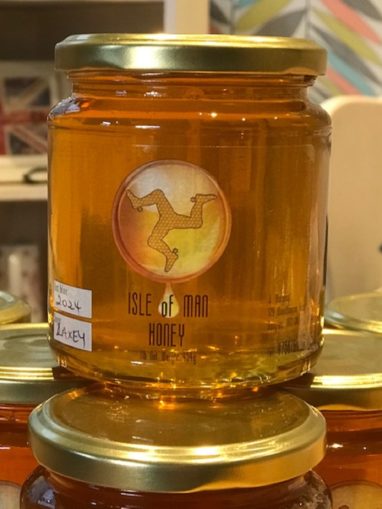
© Putin Itaboutbit
UK, Manx and Channel Island Beekeepers can send off samples of honey to be DNA tested by the UK Honey Monitoring Scheme and mine have ranged from 52 different plant sources to just 1 (bramble). New honey is always runny*, but it will set over time as the honey naturally crystalises. How quickly this happens depends on the source of pollen. Oil see rape honey sets more or less straight away, but I’ve got a few jars from a couple of years ago that still haven’t set yet.
*unless it’s from Ling Heather which is jelly-like and stays that way.
I still get stung and it still hurts and itches for a couple of days, but that’s all part of the fun. Apparently, that will stop me getting arthritis if I don’t have an anaphylactic shock induced heart attack first.
Right well, I think that’s just about enough of this old bollocks. You’d have thought I would have come up with a more interesting ending, but there you go. As Jesus said to Larry the Leper, there’s no pleasing some people.
© text & images Putin Itaboutabit 2020
The Goodnight Vienna Audio file



